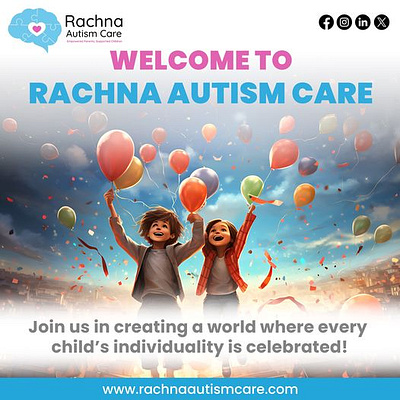Tips to Identify Early Symptoms of Autism Spectrum Disorder by Rachna Sahney Pargi
Autism Spectrum Disorder, ASD is a general term used to describe a complex neurodevelopmental disorder that affects an individual’s interaction and communication with others and their behavior. Early signs of Autism Spectrum Disorder are a crucial element in helping children and their families. Early intervention and support can help individuals with autism to lead productive and meaningful lives. The early signs of ASD and practical tips shared by an experienced advocate and specialist in autism awareness, Rachna Sahney Pargi, are further discussed as follows in this
Understanding Autism Spectrum Disorder
A range also defines Autism Spectrum Disorder: it is such a condition where each individual has manifestations of the disorder differently. The symptoms of Autism Spectrum Disorder can be as mild as they are severe, and hence they can affect different parts of communication, behavior, and sensory experience. A way to ensure good support is to spot early signs of the disorder, which is one way to improve the outcomes for kids with autism since early intervention does improve outcomes for kids with autism.
As Rachna Sahney Pargi has mentioned, «Each child is unique, so are their signs, but some common patterns that crop up quite often can be identified to help the parents, caretakers, and educators of the child identify these early symptoms».
Early Indicators of Autism Spectrum Disorder
- Delayed language or communication skills
The most easily noticeable early symptoms of Autism Spectrum Disorder are when the child lag in acquiring the communication skills. This includes:
No babbling or making limited sounds by one year of age.
No single words by two years of age; or no communicating by gestures.
Has trouble understanding or using language; for example, within her round, may not be able to point to a nose to show that the person you want refers to the nose.
As pointed out by Rachna Sahney Pargi, there is also low eye contact or disinterest in social interactions, as in the case of not responding to their name or avoiding shared activities. The above signs may be indications of the communication delay associated with ASD for a child.
- Limited Social Interaction
Another core symptom involving children with autism is problems with social interactions. Some examples include:
He will not play with other children.
Interest in typical social games and activities such as playing games or taking turns is absent.
Other people’s body space he tries to avoid, may have over hypersensitivity for touch.
These behaviors are usually observed in a social setting, such as daycare or preschool. A child with ASD may enjoy playing independently and tend to cease seeking solace from the parents or caregiver when upset.
- Repetitive Behaviors and Restricted Interests
There are also repetitive behaviors and restricted interests experienced by people who have Autism Spectrum Disorder. These may be characterized by:
Performing repetitive actions, such as hand flapping, self-rocking, or spinning objects.
Intense attachment to certain activities or rituals; gets upset if that routine/ritual is disturbed.
Preoccupied with an intense interest in a specific topic, object, or activity; may interfere with other activities
Rachna Sahney Pargi writes, «At times these behaviors may seem odd, but they offer a child with autism comfort and predictability. Parents can appreciate these repetitive behaviors because, by doing so, they know what to expect and when to intervene.
- Sensory Sensitivities
Another common feature of ASD is sensory processing difficulties. Autistic children are known to respond in an inappropriate way to sensory input, which includes sounds, lights, textures, or smells. This is characterized by behaviors such as:
Reactions to loud noises or bright lights.
Fussiness over the texture of specific foods.
Aversion to some clothes because they prove uncomfortable.
Rachna Sahney Pargi comments, It is rather striking just how this impact resonates in the day-to-day life of the child and his behavior. The earlier one can detect those triggers, it will allow parents and caregivers have the opportunity to make necessary adjustments to either create a quiet place or alter their child’s environment to minimize such sensory overload.
Tips for Parents and Caregivers
Identification of early symptoms of Autism Spectrum Disorder is just identification. On detection, proactive measures go a long way in helping to manage and support the child’s development. Some practical tips compiled by Rachna Sahney Pargi, but here is what we can do early:
- Observe and Document Behaviors
Maintaining a detailed record of your child’s behaviors, milestones, and any concerns might be very helpful in seeking a diagnosis. Record the frequency, duration, and context of any repetitive actions, communication delays, or sensory sensitivities.
- Seek Professional Evaluation
If you feel that your child might have autism, take them to a pediatrician or a child psychologist for evaluation. In many instances, early diagnosis gives one access to invaluable resources and other interventions, like speech therapy, occupational therapy, and behavioral support.
- Educate yourself and others
The more you understand the symptoms of Autism Spectrum Disorder, the better you will be able to advocate for your child. Learn about autism and teach your family members, teachers, and caregivers. Rachna Sahney Pargi emphasizes the need to develop an informed support system for your child.
- Routine and Consistency
Children with autism often thrive on routine and structure. Establish a daily routine that will serve as a safe and predictable foundation for them. Implement visual schedules, timers, or cues to help your child prepare for the events of the day.
- Cultivate Patience and Compassion
It’s not easy to raise an autistic child, but patience and sympathy are also helpful. Each child has different characteristics and the progress will be slow. Reward the small achievements and be supportive of the individual needs of your child.
Final words by Rachna Sahney Pargi
Rachna Sahney Pargi says, «Early intervention and individualized care to children are very important as they need proper care.» This is hard to track down early signs of Autism Spectrum Disorder, but it needs to be present in the beginning to initiate help and support. It is through the love of parents and patience, understanding and understanding action that allow them to facilitate their child to understand issues concerning the issue of autism.
The journey of understanding and discovering ways to deal with autism is quite a long one and full of the unknown, but it also is a pathway of growth and discovery. Correct support, right environment, and pro-activity ensure that children with autism get the best start in life.
If you feel that your child is not developed or suspect him to have Autism Spectrum Disorder, contact a healthcare professional and ask for advice. Early detection and intervention present the best ways through which children who suffer from autism can be helped reach their maximum capacities.


